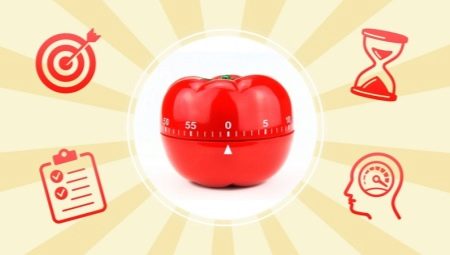Have you ever had to note at the end of working time that you worked tirelessly all day, and did not manage to cope with the tasks set for the day? Or, by the end of the weekend, to understand that they did not finish cleaning, and did not find time to overload the laundry either? Perhaps each of us faces such problems. The thing is that we are not planning our time correctly, experts in the field of time management say.
To solve the problem, they suggest using a method that was invented long before the term “time management” became widespread in business. It's about a daily routine called Pomodoro.

How did the Pomodoro method come about?
The emergence of such a technique as Pomodoro, we are obliged to the Italian Francesco Cirillo. In the 80s of the last century, as a student, he somehow thought about why the exam time is faster than he prepared for it, although the young man spent all his time and energy studying, as it seemed to him. A diligent and meticulous young man suggested that he was distracted a lot during tasks, and decided to find a way to concentrate on his goal at least for a while.
To begin with, he determined a segment of 10 minutes. Time was detected using an ordinary kitchen timer, which had the form of a tomato - hence the name of the method that became common in the whole world in the future, simply “tomato” in Russian. True, for introducing him into the sphere of time management on a day-to-day basis, you need to say “thank you” not to the Italian guy, but to Staffuff Netebberg. Little is known about him. Of the public facts - for about two decades he has been engaged in independent software development, is a mentor on flexible methodologies for developing information systems.
So, it was he, thanks to mathematical programming thinking, who created the training manual on the use of the Pomodoro method and called it “Tomato Time Management”. In it, he not only readily explained this principle, but also diversified his story with vivid illustrations. As a result, he spread the “tomato” theme among professionals and fans of time management.

Features
The "tomato" system is simple, like all ingenious. The main rule is to break your day into small segments, each of them is called a tomato. The optimal time allotted for “eating” one tomato is 25 minutes. So, we set the timer, you probably have one in the kitchen, perhaps not in the form of a tomato, but some other, if it is not there, just set an alarm.
The next 25 minutes you should focus on solving the problem.. You should not be distracted by anything - neither phone calls, nor sound from the radio, nor even the TV. Coffee with a sandwich will also have to be postponed. And only after the alarm sounds about the end of the allotted time, you have every right to a break. Thus, you are, as it were, concluding an employment contract with yourself. For each working "tomato" day, you set yourself a specific task and will certainly fulfill it.
It is unlikely that you will allow yourself to not fulfill the obligations of the contract, if it comes to a large fee, and in this case - a deal with your own conscience works in the vast majority of cases without fail.

Why is it needed?
This method of time management is especially in demand in the modern world, when a person is simply shrouded in the temptations of "distracting for a second." Messages in social networks, SMS, phone calls, advertising mailing. But "not to think about the seconds down" has long been recommended to us by the classics of Russian pop music. In fact, the tomato technique allows you to follow the rule sung in the song. It can be used not only by businessmen, but also by schoolchildren and students during their studies, it is no coincidence that it was the university student who invented it. By the way, according to Italian author Francesco Cirillo, his method helps to achieve the following goals:
- maintain determination and achieve your goals;
- to improve the quality of the educational or work process;
- increase the efficiency of labor or the process of obtaining knowledge;
- give determination in difficult situations.
However, do not forget that you will not be full of tomatoes alone. This method should be used for greater efficiency, along with competent planning of a business or educational process.
But the method, born in the head of an Italian student, will certainly help you achieve your goals.

The principle of application of technology
Before starting the timer, make a list of tasks that you intend to solve on this particular work day. Make them a description. In order for the method to work, you need to clearly understand what exactly you want to achieve. If you decide, turn on the timer.
The duration of the "tomato"
In general, it is believed that the optimal time for "ripening tomato" is 25 minutes. That is exactly what Staffan Neteberg mentioned in his textbook above. Recently, however, some researchers have argued that this time can be increased. Perhaps they are right, but for starters, it’s probably still better to use a 25-minute span of years tested by different minds.
Pauses
They are no less important than those 25 minutes during which you are focused on work. So, I did the job - and 5 minutes walk boldly. That is how many experts in the field of "tomato" time management recommend giving away for a break.
Distractions
It’s unlikely to get rid of them at all.After all, there are important calls to which we must be distracted, there is a chance of an unexpected visit to your office or home, and there are understandable urgent natural human needs. The author of the method, Francesco Cirillo, recommended in such cases to pause the timer, and after completion of urgent matters, start it again.
Some contemporary followers believe that the degree of need for distraction should be evaluated on a 10-point scale. And if something urgent you yourself evaluate in one point, then, then, it is not worth it to "malnutrition our tomato" in one sitting.
If the urgency on a 10-point scale exceeds 7, then the timer will have to be activated.

Rules and Tips
If the task is not too difficult, or you can’t immediately concentrate on 25 minutes, then divide your “tomato” into “slices”. Start at intervals of 10-15 minutes. If, on the contrary, you understand that your task does not "fit in your mouth" in 25 tomato minutes, increase the time it is eaten.
If you coped with the task before the timer signal sounded, do not try to turn it off. Consider this your bonus vacation time. You can spend it on planning the following tasks, talking with colleagues, reading something, answering a phone call. And only then arrange a “legitimate” 5-minute break.
There are people who do not use this method, because they are afraid not to be in time before the “fateful” call. Try to overcome these childhood fears.. To get started, put a nice signal to ring the alarm. By the way, now there are a lot of computer programs and applications for phones that are designed specifically to correctly use the “tomato” method. According to most experts, it does not matter which assistant you use - an old kitchen timer or a newfangled design. The main thing, remember, "an unfinished tomato" is like lost time. And we always have it enough. In addition to work, study, there is still so much to be done in life.
Therefore, we recall once again the Russian proverb, which the author of the book about tomato time management, Shtaffan Neteberg, could quite use as an epigraph - "Do the job - walk boldly." We have a lot of time ahead. The main thing is to use it rationally.











